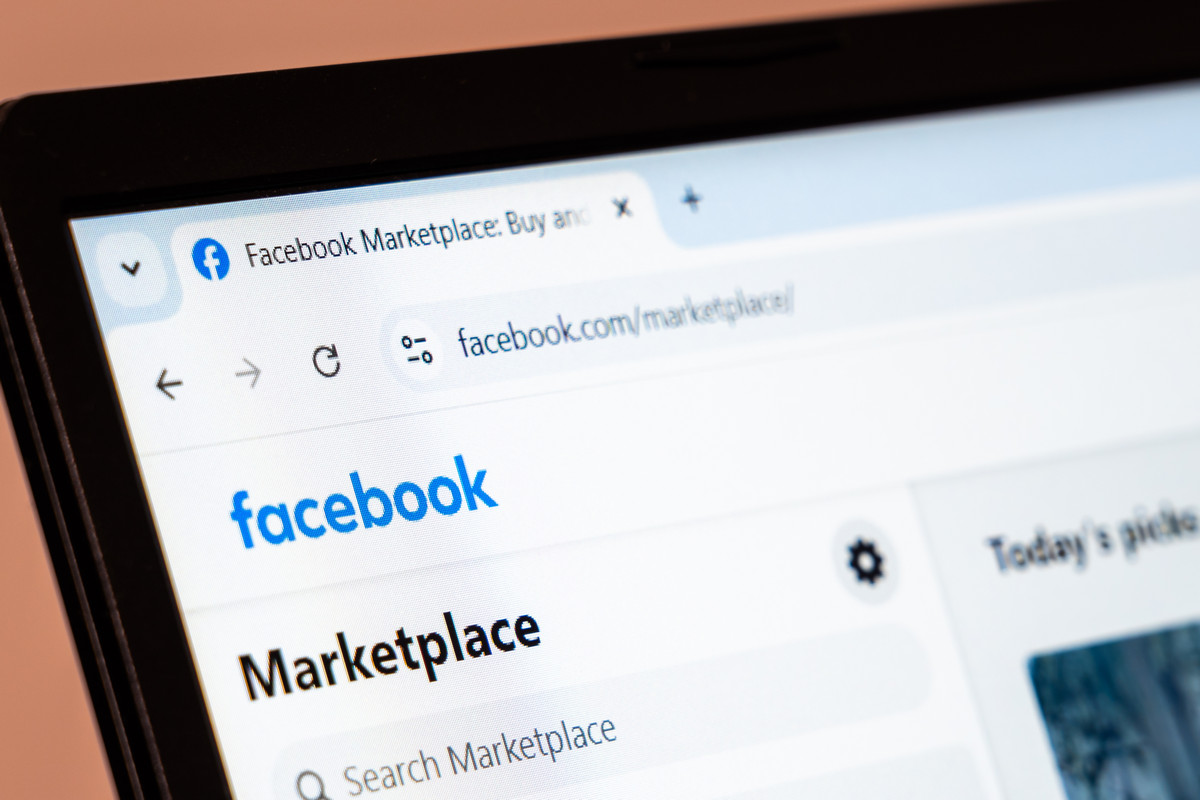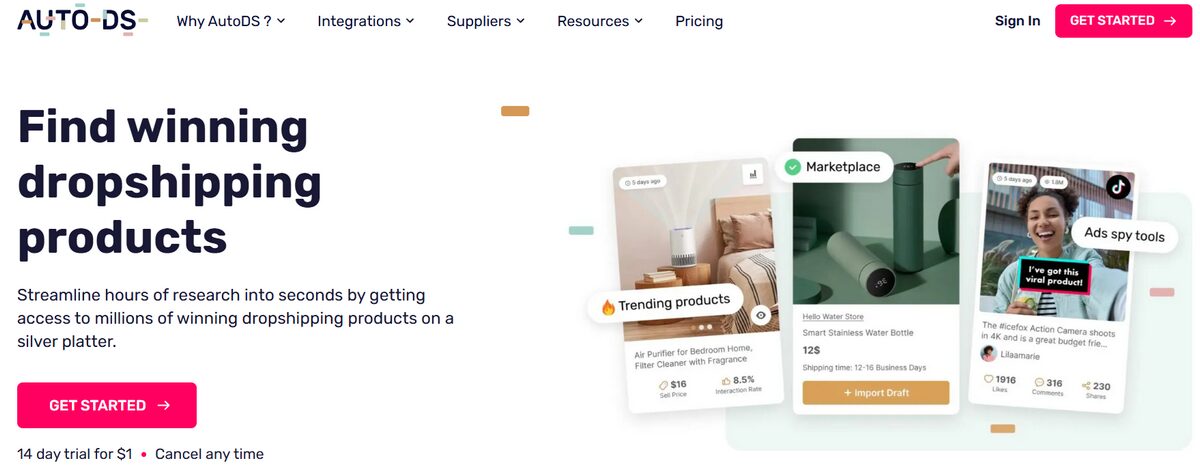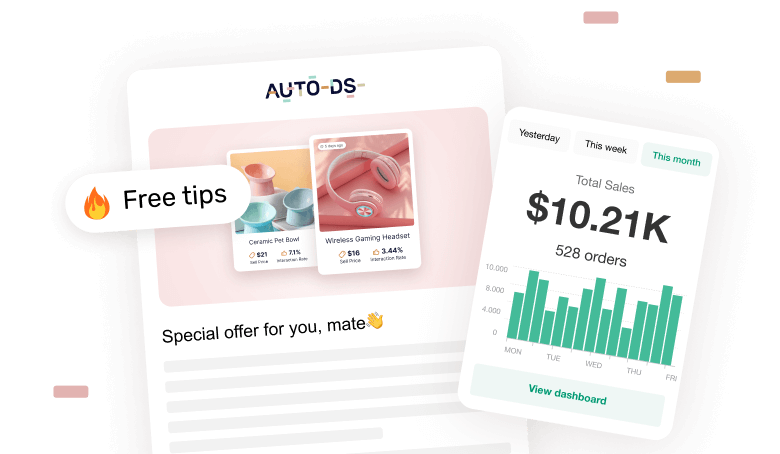If you’re clearing out your closet or building a real business, Facebook Marketplace is the place. With a simple setup, it’s one of the most accessible platforms for online selling.
For dropshippers, it’s a powerful space to test products, reach customers, and scale. But if you’ve ever listed something (or thought about it), you’ve probably wondered: does Facebook Marketplace charge fees? The answer is yes… but not always. And knowing exactly when and how much can make all the difference.
That’s where tools like AutoDS, for example, make a real impact. AutoDS automates listings and calculates fees in real-time, helping dropshippers grow without getting lost in spreadsheets. Still, having the right info is key to protecting your margins and making smart decisions. That’s why in this guide, we’ll break down every Facebook Marketplace fee and share strategies to boost profits.
Facebook Marketplace offers free local sales but charges a 10% fee on shipped orders through Marketplace Checkout.
Selling fees in Facebook Marketplace apply only when an item sells, with no listing or subscription costs to get started.
Chargebacks and disputes can trigger a $20 fee in Facebook Marketplace, making communication and tracking details critical.
Smart strategies like bundling, pricing buffers, and local suppliers help offset platform fees and protect profit margins.
Automation tools like AutoDS optimize the Facebook Marketplace workflows, reduce costs, and help dropshippers stay efficient and competitive.
What is Facebook Marketplace?

First things first: at its core, Facebook Marketplace is Meta’s built-in peer-to-peer platform for buying and selling, designed to connect people right where they’re already scrolling. Whether it’s someone clearing out their garage or a small business running daily sales, Marketplace makes it easy to list items and reach local or nationwide buyers.
With over a billion users and a built-in trust system through Messenger and reviews, it’s become a go-to space for online sales. Sellers can offer products for local pickup (using cash or external payment apps) or enable shipping through Marketplace Checkout, Facebook’s own payment and fulfillment system. It’s simple, versatile, and most importantly, full of potential for those diving into Facebook Marketplace dropshipping.
Best part? It’s free to use in most cases, making it one of the most accessible platforms out there. But there are fees depending on how you sell, and that’s exactly what we’ll break down next.
Fee Breakdown For Dropshippers

Before we dive into the numbers, here’s something important to keep in mind: as a dropshipper, you can use Facebook Marketplace purely as a storefront, not as a fulfillment service. That means you’re free to set your own prices and include the shipping cost from your supplier directly in the product price.
This gives you more control over your profit margins and allows you to run your store without relying entirely on Facebook’s systems; though in some cases, like using Marketplace Checkout, certain fees will still apply.
Let’s break it all down by scenario so you know exactly what to expect (and how to avoid surprises).
Local Pickup Sales (Cash or External Payment)
If you’re selling locally and arranging in-person pickups, good news: Facebook charges zero fees for these transactions. That’s right: no selling fees, no processing fees, nothing.
Since payments happen off-platform (cash, bank transfer, or apps like Venmo), you keep 100% of the sale price. There’s no shipping involved either, which makes this the most margin-friendly way to sell on Marketplace.
This method works especially well in urban areas, where buyer traffic is high and pickups are easy to coordinate. Plus, if you’re working with a local supplier or reselling hot products nearby, it can be a smart, low-cost move.
Shipped Orders via Marketplace Checkout
Selling with shipping enabled? Here’s the catch: Facebook takes a 10% commission on the total sale (item price, shipping, and tax included) with a minimum fee of $0.80 per order. Depending on the payment method, you might also see a 2.9% processing fee, though it’s often bundled into that 10%.
On top of that, you’re responsible for shipping costs, which you’ll pay upfront using Facebook’s shipping labels. That means every shipped order slices into your profit unless you’ve priced smartly.
Bottom line? This setup erodes your margins, so it’s essential to bake all these fees into your pricing strategy. If done right, it can still be profitable, but ignoring these numbers is where dropshippers get burned.
Chargebacks & Disputes
While rare, chargebacks on Facebook Marketplace can sting, especially if Facebook sides with the buyer. In those cases, you’re looking at a $20 fee per dispute. And no, that doesn’t include the cost of the item or the time spent dealing with the issue.
To stay on the safe side, your best defense is a proactive approach: always upload valid tracking info, respond quickly to buyer messages, and keep your communication clear and professional. The more trust signals you provide, the better your chances of avoiding disputes or winning them when they happen.
Advertising on Marketplace
While listing on Facebook Marketplace is free, boosting your product visibility isn’t. Meta offers optional “Boost” ads (now under the Advantage+ umbrella), which allow you to promote listings to reach a wider audience across Facebook and Instagram.
These ads are billed separately from any selling fees, and you set the budget. For dropshippers testing new products or scaling up bestsellers, a small ad spend can make a big difference. Just make sure your ad performance justifies the cost. After all, visibility is great, but conversions pay the bills.
| Facebook Marketplace Fees | Cost |
|---|---|
| Subscription cost | No subscription fee. |
| Listing Fee | $0 |
| Local Pickup Sales (Cash or External Payment) | $0 |
| Shipped Orders via Marketplace Checkout | 10% of the total sale (item price, shipping, and tax included) with a minimum fee of $0.80 per order. |
| Chargebacks & Disputes | $20 if Facebook rules in favor of the buyer. |
Dropshipping Strategies To Offset Fees
Facebook Marketplace may be cost-effective, but those small percentages can quietly eat into your profits if you’re not careful. Luckily, there are smart ways to work around (or at least soften, come on) the blow of fees without cutting corners.
From automation tools to clever pricing tactics, here are some strategies dropshippers can use to protect their margins and keep more from every sale.
Automate your Store
Automation is a game-changer in dropshipping, and on Facebook Marketplace, you’ve got to play it smart. Tools like AutoDS help you stay on top of stock levels, sync product data, and streamline orders without breaking a sweat.
Just be mindful of pacing. Facebook’s system isn’t a fan of aggressive activity, so keep automation steady but natural. With the right balance, you get the power of hands-free selling without raising red flags. So, automate wisely: set it, but don’t over-forget it.
💡 Pro Tip: Configure AutoDS to update your stock and prices at intervals that mimic natural seller behavior (e.g., every few hours rather than every few minutes). This helps avoid Facebook’s anti-bot detection while keeping your listings fresh and competitive.
Ship from Selected Suppliers
Choosing reliable suppliers is crucial to keeping your Facebook Marketplace dropshipping business smooth and fee-efficient. Opt for suppliers who offer fast shipping from warehouses close to your target customers, preferably local or regional.
Shipping from selected suppliers helps reduce delivery times and lowers the risk of disputes or chargebacks, which can cost you extra fees. Plus, it improves customer satisfaction and boosts your store’s reputation. Winning combo, right?
Factor in 10% Fee When Pricing
That 10% Marketplace fee might not seem like much until it eats half your profit on a $10 item. For low-cost products, every cent counts, so your pricing strategy has to do some heavy lifting.
The fix? Price with the fee in mind from the start. Consider bundling items to raise your average order value, or focus on higher-margin products that can absorb the cost without hurting your bottom line. Smart pricing isn’t just about covering costs; it’s about staying profitable.
💰 Financial Tip: Before listing any product, plug your numbers into a profit calculator. Factoring in Facebook’s 10% fee upfront helps avoid surprises and protects your margins.
Bundle Lightweight Items
If you’re selling low-cost or lightweight products, bundling is your secret weapon. Instead of listing a $10 item on its own and watching Facebook take a flat 10% cut, group a few together to increase the order value and dilute the fee’s impact.
Buyers get more value, you keep more margin: it’s a win-win. Think “3-pack,” “essentials kit,” or even “buy 2, get 1.” The more you raise the total cart value, the less painful that commission feels.
Test Creatives & Pricing via Ads
Before committing to a product or pricing strategy, run small ad tests using Facebook’s “Boost” or Advantage+ features. It’s a quick way to gauge what catches attention, whether it’s the price, the product image, or the headline that does the heavy lifting.
Use these insights to refine your listings and scale only what performs. A few dollars in testing can save you from launching a dud, or worse, overpaying fees on underperforming products.
💸 Manage fees + automate listings on FB Marketplace. AutoDS helps. Trial = $1.
Dropshipping Pitfalls: What to Watch For
Even with all its perks, Facebook Marketplace isn’t without a few quirks. Between fees, policies, and platform limitations, dropshippers can run into the occasional speed bump.
But don’t worry, none of these are deal-breakers. By knowing what to watch out for, you can sidestep the common mistakes and keep your business running smoothly.
High Fees on Shipped Orders
Here’s the part that catches many new dropshippers off guard: the 10% fee isn’t just on the product price, it’s on the entire transaction amount. That means item + shipping + tax.
For lower-ticket items, this can eat into your margins faster than expected, especially if you’re covering shipping or running thin-profit strategies. The fix? Price accordingly, or focus on products with higher perceived value to absorb the fee without hurting your earnings.
Restricted Niches
Not everything is fair game on Facebook Marketplace. Certain categories —like supplements, medical supplies and devices, adult products, weapons (yeah, don’t go there), and anything gambling-related— are either heavily restricted or outright banned.
Listing these can lead to removals, warnings, or even account bans. So, if you’re planning to scale sustainably, stick to safe, compliant niches. Think home goods, accessories, gadgets; products Facebook won’t raise an eyebrow at.
Facebook AI Risks
Facebook’s algorithms are always watching, and they don’t always explain themselves. Overusing automated tools, posting too frequently, or repeating similar listings can trigger flags in the system.
Worst-case scenario? Your listings get “ghosted”: they’re live, but invisible to buyers. To stay in the clear, keep automation natural, vary your titles and descriptions, and monitor performance closely. A bit of subtlety goes a long way with the algorithm.
Unreliable Suppliers
A slow supplier can sink a great product. When orders take weeks to arrive (or worse, never show up), you risk disputes, bad reviews, and lost customers.
To avoid the drama, vet your suppliers carefully. Look for consistent delivery times, clear communication, and solid ratings.
💡 Pro Tip: Order a sample from your supplier before listing the product. It’s a small step that can save you big headaches down the line.
Optimized Dropshipping Workflow on Facebook Marketplace
Reducing unnecessary fees on Facebook Marketplace isn’t just about knowing the rules, it’s about running a workflow that keeps your margins healthy from the start.
From sourcing and pricing to fulfillment and communication, each step can either protect your profits or slowly chip away at them. With the right systems in place, you can stay ahead of the curve (and the costs).
Product Research & Sourcing

Product research is the foundation of any successful dropshipping business, and on Facebook Marketplace, it’s no different. Finding trending, high-demand products that fit your target audience can make or break your profits, especially once fees come into play.
This is where tools like AutoDS’ product finding tools become invaluable. AutoDS scans multiple suppliers and marketplaces to spot winning products, helping you source items that not only sell well but also keep your margins healthy after fees.
By leveraging smart product research, you avoid wasted time and costly mistakes, making your sourcing process smoother and more profitable from the start.
Choose Local Warehouses For Speed
Speed matters in dropshipping, especially on Facebook Marketplace, where buyers expect quick delivery. Shipping delays can lead to unhappy customers, disputes, and even fee penalties.
Choosing suppliers with local warehouses or faster shipping options helps you meet these expectations and keeps your business running smoothly. AutoDS makes this easier by offering access to private suppliers with warehouses closer to your target markets, cutting delivery times significantly.
Faster shipping means happier customers, fewer disputes, and ultimately, better profit retention after fees.
Listing Optimization
A well-optimized listing is your best chance to attract buyers and minimize confusion. Use high-quality photos that showcase your product clearly and from multiple angles. Clear, concise titles that include relevant keywords will boost your product’s visibility in Facebook Marketplace search results.
Don’t forget to be upfront about shipping timelines. Transparency builds trust and reduces the risk of disputes or cancellations. When buyers know what to expect, they’re more likely to complete the purchase and leave positive feedback.
🆕 Beginner’s Tip: The AutoDS’ AI Product Title & Description Generator helps you craft SEO-friendly, high-converting copy in seconds to boost visibility and build trust from the first scroll.
Pricing Strategy
When selling on Facebook Marketplace, don’t stop at just covering the product cost. You’ll want to factor in:
- Your supplier’s price.
- Shipping costs (whether paid by you or the customer).
- The 10% Facebook fee (on item + shipping + tax).
- A buffer to absorb possible chargebacks or returns.
Smart sellers price with foresight, not guesswork. That small cushion can be the difference between growing your store or your stress.
Order Fulfillment & Communication
How you handle orders and updates plays a huge role in shaping the customer experience. It’s not just a back-end task; it’s part of your store’s reputation.
The basics go a long way: process orders promptly, upload tracking info without delay, and keep buyers informed at each step. A little clarity now can save you from big headaches later. Tools like AutoDS can automate much of this flow, so you stay consistent, even when the orders start piling up.
Marketing & Scaling
Scaling on Facebook Marketplace goes beyond just spending money on ads: it’s about working smarter. Kick things off with Campaign Budget Optimization (CBO) campaigns to test multiple creatives and figure out what really clicks with your audience. Once you spot the winners, pour your budget into those to multiply your sales.
At the same time, give your top listings an extra push by boosting them. This expands your reach and puts your products in front of more potential buyers. With this combo, you get laser-focused growth without wasting a cent, turning every ad dollar into pure profit.
Frequently Asked Questions
Does Facebook Marketplace Charge A Fee & Subscription?
Yes, Facebook Marketplace charges a fee on shipped sales, but there’s no subscription cost, and listing products is free. Local sales using cash or external payments have no fees, making it a flexible option depending on how you fulfill orders.
How Much Does Facebook Marketplace Take Per Sale?
Facebook charges a 10% fee on shipped orders, or a minimum of $0.80 per shipment. Local pickups are still free, meaning you only pay fees when using Facebook’s checkout and shipping services.
Are Facebook Marketplace Fees Expensive?
No, Facebook Marketplace fees are affordable for local sales. However, the 10% fee on shipped items can cut into margins. Still, it’s often cheaper than other platforms, especially if you price smart and leverage local transactions.
Can I Dropship On Facebook Marketplace?
Yes, dropshipping is allowed on Facebook Marketplace as long as you comply with its legal guidelines, making it a viable and profitable option for many sellers.
Is There A Facebook Marketplace Dropshipping Case Study?
Yes, there is a Facebook Marketplace Dropshipping Case Study available that provides detailed insights and practical tips for successfully dropshipping on Facebook Marketplace.
Is Selling On Facebook Marketplace Worth It?
Yes, selling on Facebook Marketplace is definitely worth it. Especially for beginners, thanks to its free organic reach and relatively low competition compared to other platforms.
Conclusion
Let’s be honest: fees aren’t the most exciting part of eCommerce. But understanding them can mean the difference between scaling smart and leaking profits without even noticing. That’s why Facebook Marketplace remains a powerful channel for dropshippers, especially if you know where (and when) the fees kick in. Knowing how the platform works is key to staying profitable.
From local sales to shipped orders, every cent counts. That’s why building an optimized workflow, tweaking your pricing, and choosing the right tools make all the difference. In that sense, AutoDS helps dropshippers reduce Facebook Marketplace fees by automating listings, syncing real-time costs, and sourcing from local warehouses, so you can focus on scaling, not micromanaging.
Looking to sharpen your strategy even further? Don’t miss the following reads on:
















